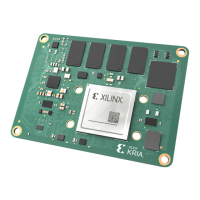Voltage Rail Monitoring
A subset of the SOM rails can be monitored using the system monitor (SYSMON) available on
the Zynq UltraScale+ MPSoC. For more informaon on the SYSMON, see UltraScale Architecture
System Monitor User Guide (UG580).
Table 10: Voltage Rail Domains
Domain SYSMON on Zynq UltraScale+ MPSoC Power Rail on SOM
+5V Input V
P
/V
N
V
IN_5V0
PS V
CC_PSINTLP
V
CC_PSINTFP
V
CC_PS_0V85
(0.85V)
PS V
CC_PSAUX
V
CC_PS_1V80
(1.8V)
PL V
CCINT
V
CC_PL_0V72
(0.72V)
PL V
CCAUX
V
CC_PL_1V80
(1.8V)
PL V
CCBRAM
V
CC_PL_0V85
(0.85V)
The Zynq UltraScale+ MPSoC SYSMON is supported for Linux applicaons by the Xilinx analog
mixed signal (AMS) driver, available in the Xilinx ADC GitHub. The SYSMON is supported for
bare-metal applicaons by the SYSMONPSU driver.
SOM Power Integrity
The K26 SOM is equipped with adequate decoupling capacitors on all PS and PL voltage rails to
support a dened set of transient step loads. The programmable logic (PL) and processing system
(PS) designs must not exceed the specied maximum current limit and the corresponding step
loads as listed in the following tables.
Table 11: PL Design Limits
Voltage Rail Voltage (V)
Maximum Current
(A)
Step Load (% of Maximum Current)
V
CCINT
0.72 6.5 50
V
CCINT_VCU
0.9 3.5 50
Table 12: PS Design Limits
Voltage Rail Voltage (V)
Maximum Current
(A)
Step Load (% of Maximum Current)
V
CC_PSINTLP
and
V
CC_PSINTFP
0.85 3.5 25
V
CCO_PSIO
1.8 0.300 100
Chapter 2: Electrical Design Considerations
UG1091 (v1.0) April 20, 2021 www.xilinx.com
Carrier Card Design for Kria SOM 36

